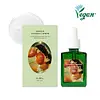What's inside
What's inside
 Key Ingredients
Key Ingredients

 Benefits
Benefits

 Concerns
Concerns

No concerns
 Ingredients Side-by-side
Ingredients Side-by-side

Water
Skin ConditioningHippophae Rhamnoides Fruit Water
SolventNiacinamide
SmoothingPropanediol
Solvent1,2-Hexanediol
Skin ConditioningCamellia Sinensis Leaf Water
MaskingCaprylic/Capric Triglyceride
MaskingCastor Oil/Ipdi Copolymer
Acrylates/C10-30 Alkyl Acrylate Crosspolymer
Emulsion StabilisingTromethamine
BufferingXanthan Gum
Emulsifying3-O-Ethyl Ascorbic Acid
Skin ConditioningAdenosine
Skin ConditioningDisodium EDTA
Allantoin
Skin ConditioningBifida Ferment Filtrate
Skin ConditioningEthylhexylglycerin
Skin ConditioningButylene Glycol
HumectantMelaleuca Alternifolia Leaf Extract
PerfumingCaprylyl Glycol
EmollientWater, Hippophae Rhamnoides Fruit Water, Niacinamide, Propanediol, 1,2-Hexanediol, Camellia Sinensis Leaf Water, Caprylic/Capric Triglyceride, Castor Oil/Ipdi Copolymer, Acrylates/C10-30 Alkyl Acrylate Crosspolymer, Tromethamine, Xanthan Gum, 3-O-Ethyl Ascorbic Acid, Adenosine, Disodium EDTA, Allantoin, Bifida Ferment Filtrate, Ethylhexylglycerin, Butylene Glycol, Melaleuca Alternifolia Leaf Extract, Caprylyl Glycol
Citrus Tangerina Extract
TonicButylene Glycol
HumectantGlycerin
HumectantNiacinamide
SmoothingCitrus Nobilis Peel Extract
MaskingSodium Hyaluronate
HumectantHamamelis Virginiana Extract
AntiseborrhoeicPolyglutamic Acid
Skin ConditioningHippophae Rhamnoides Fruit Extract
Skin ConditioningBeta-Glucan
Skin ConditioningGlycyrrhiza Glabra Root Extract
BleachingCamellia Sinensis Leaf Extract
AntimicrobialRosmarinus Officinalis Leaf Extract
AntimicrobialCentella Asiatica Extract
CleansingChamomilla Recutita Extract
Skin ConditioningScutellaria Baicalensis Root Extract
AstringentPolygonum Cuspidatum Root Extract
AntioxidantAvena Sativa Kernel Extract
AbrasiveSambucus Nigra Flower Extract
RefreshingAlchemilla Vulgaris Extract
AstringentAmaranthus Caudatus Seed Extract
Skin ConditioningOlea Europaea Leaf Extract
PerfumingVeronica Officinalis Extract
Skin ConditioningMentha Piperita Leaf Extract
Skin ConditioningUlmus Davidiana Root Extract
Skin ConditioningCynara Scolymus Extract
Chamaecyparis Obtusa Leaf Extract
Skin ConditioningAscorbic Acid
AntioxidantPanthenol
Skin ConditioningCarbomer
Emulsion StabilisingArginine
MaskingAdenosine
Skin ConditioningDisodium EDTA
Citrus Tangerina Extract, Butylene Glycol, Glycerin, Niacinamide, Citrus Nobilis Peel Extract, Sodium Hyaluronate, Hamamelis Virginiana Extract, Polyglutamic Acid, Hippophae Rhamnoides Fruit Extract, Beta-Glucan, Glycyrrhiza Glabra Root Extract, Camellia Sinensis Leaf Extract, Rosmarinus Officinalis Leaf Extract, Centella Asiatica Extract, Chamomilla Recutita Extract, Scutellaria Baicalensis Root Extract, Polygonum Cuspidatum Root Extract, Avena Sativa Kernel Extract, Sambucus Nigra Flower Extract, Alchemilla Vulgaris Extract, Amaranthus Caudatus Seed Extract, Olea Europaea Leaf Extract, Veronica Officinalis Extract, Mentha Piperita Leaf Extract, Ulmus Davidiana Root Extract, Cynara Scolymus Extract, Chamaecyparis Obtusa Leaf Extract, Ascorbic Acid, Panthenol, Carbomer, Arginine, Adenosine, Disodium EDTA
 Reviews
Reviews

Ingredients Explained
These ingredients are found in both products.
Ingredients higher up in an ingredient list are typically present in a larger amount.
Adenosine is in every living organism. It is one of four components in nucleic acids that helps store our DNA.
Adenosine has many benefits when used. These benefits include hydrating the skin, smoothing skin, and reducing wrinkles. Once applied, adenosine increases collagen production. It also helps with improving firmness and tissue repair.
Studies have found adenosine may also help with wound healing.
In skincare products, Adenosine is usually derived from yeast.
Learn more about AdenosineButylene Glycol (or BG) is used within cosmetic products for a few different reasons:
Overall, Butylene Glycol is a safe and well-rounded ingredient that works well with other ingredients.
Though this ingredient works well with most skin types, some people with sensitive skin may experience a reaction such as allergic rashes, closed comedones, or itchiness.
Learn more about Butylene GlycolDisodium EDTA plays a role in making products more stable by aiding other preservatives.
It is a chelating agent, meaning it neutralizes metal ions that may be found in a product.
Disodium EDTA is a salt of edetic acid and is found to be safe in cosmetic ingredients.
Learn more about Disodium EDTANiacinamide is a multitasking form of vitamin B3 that strengthens the skin barrier, reduces pores and dark spots, regulates oil, and improves signs of aging.
And the best part? It's gentle and well-tolerated by most skin types, including sensitive and reactive skin.
You might have heard of "niacin flush", or the reddening of skin that causes itchiness. Niacinamide has not been found to cause this.
In very rare cases, some individuals may not be able to tolerate niacinamide at all or experience an allergic reaction to it.
If you are experiencing flaking, irritation, and dryness with this ingredient, be sure to double check all your products as this ingredient can be found in all categories of skincare.
When incorporating niacinamide into your routine, look out for concentration amounts. Typically, 5% niacinamide provides benefits such as fading dark spots. However, if you have sensitive skin, it is better to begin with a smaller concentration.
When you apply niacinamide to your skin, your body converts it into nicotinamide adenine dinucleotide (NAD). NAD is an essential coenzyme that is already found in your cells as "fuel" and powers countless biological processes.
In your skin, NAD helps repair cell damage, produce new healthy cells, support collagen production, strengthen the skin barrier, and fight environmental stressors (like UV and pollution).
Our natural NAD levels start to decline with age, leading to slower skin repair, visible aging, and a weaker skin barrier. By providing your skin niacinamide, you're recharging your skin's NAD levels. This leads to stronger, healthier, and younger looking skin.
Another name for vitamin B3 is nicotinamide. This vitamin is water-soluble and our bodies don't store it. We obtain Vitamin B3 from either food or skincare. Meat, fish, wheat, yeast, and leafy greens contain vitamin B3.
The type of niacinamide used in skincare is synthetically created.
Learn more about Niacinamide